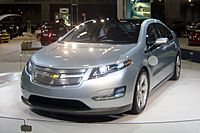Plug-in hybrid facts for kids

A plug-in hybrid car is similar to a conventional hybrid vehicle—both use a gasoline engine as well as an electric motor. A plug-in hybrid differs primarily in that it can be plugged in to charge the batteries, while a conventional hybrid relies solely on energy generated from braking, coasting or from the gasoline engine.
However, a plug-in hybrid uses larger battery packs that can be recharged by connecting to common household electricity. Plug-in hybrids can be driven for long distances—from a few miles to as much as 40 miles—without using any gasoline. Plug-in hybrid cars are also known as plug-in hybrid electric vehicles or PHEVs. Plug-in hybrid cars that use a gas engine exclusively for recharging batteries—rather than directly powering the wheels—are also called Extended-Range Electric Vehicles or E-REVs.
Fueling a car with electricity is about 5 times cheaper than fueling it with gasoline. That is equivalent to buying gasoline at less than $1 per gallon. It also reduces greenhouse pollution and helps reduce crude oil imports. Also plug-in hybrids produced substantially lower greenhouse gas emissions than either conventional gasoline cars or unplugged hybrids. The reduction in emissions results from electric operation being much more efficient than gasoline operation.
Criticisms
Criticisms of the hybrid include the additional cost, weight, and size of a larger battery pack. But The extra weight of the batteries will be offset somewhat by the reduced weight of the gas engine.
It is obvious for most people that internal combustion engine cars cannot represent the future anymore because of the oil reserves that are estimated to be finished in forty or fifty years. Obviously, Plug-in vehicles cannot be considered a short term option because we lack the needed infrastructure and capable batteries for increasing the autonomy that is currently limited. The general opinion was that, at least for the next seven or eight years, Plug-ins are not going to become the standard in hybrid vehicles and that regular HEVs will have the biggest proportion on the market.
Images for kids
-
The Mitsubishi Outlander PHEV is the world's all-time best-selling plug-in hybrid. Global sales reached 290,000 units through September 2021.
-
The Lohner-Porsche Mixte Hybrid was the first gasoline-electric plug-in hybrid automobile
-
Lithium-ion battery pack, with cover removed, in a CalCars "PRIUS+" plug-in hybrid converted Toyota Prius converted by EnergyCS
-
Three plug-in converted Toyota Prius recharging at San Francisco City Hall public charging station
-
The Chevrolet Volt operates primarily as a series hybrid.
-
15 lead–acid batteries, PFC charger, and regulators installed into WhiteBird, a PHEV-10 conversion of a Toyota Prius
-
All-electric range, in miles, for several popular model year 2013 plug-in hybrids, as observed in testing by Popular Mechanics magazine. Providing greater all-electric range adds cost and entails compromises, so different all-electric ranges may suit different customers' needs.
-
The Chevrolet Volt was the world's top selling plug-in hybrid until September 2018.
See also
 In Spanish: Vehículo híbrido eléctrico enchufable para niños
In Spanish: Vehículo híbrido eléctrico enchufable para niños












